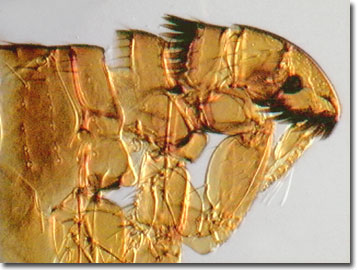Oblique Digital Image Gallery
Flea (Ctenocephalides)
Ctenocephalides felis is commonly known as the cat flea and Ctenocephalides canis is known as the dog flea. Both are members of the 1,600 species referred to as fleas, order Siphonaptera ("wingless siphon"). These blood-sucking insects can be found worldwide, from the Arctic to the tropics.

View a second image of a flea.
Adults vary in length from 0.04 to 0.4 inches (1 to 10 millimeters). Fleas are able to jump over eight inches, which is roughly the equivalent of a human jumping over the Statue of Liberty. Specialized anatomical structures allow them to attach to the skin of their hosts, but they pass easily from one host to another. Consequently, fleas can transmit a number of diseases. Most notably, the flea is responsible for transmitting the Black Death, bubonic plague, which killed a quarter of the population of Europe during the Middle Ages. Today the flea is known to transmit tapeworm and haemobartonellosis, a blood disorder that can be fatal to cats. Serious infestations can cause severe inflammation, intense itching and even anemia. Also, a number of pets, as well as people, have allergies to flea saliva that can result in rashes and hair loss.
The flea's life cycle consist of four stages: egg, larva, pupa and adult. Eggs are laid on the body of the host animal, but since they aren't sticky they can drop in any number of places. The larva resembles a small legless caterpillar and it feeds on dried excrement, dried bits of skin, dead mites, dried blood, and other organic debris. Fecal matter from the parent flea is essential to the successful metamorphosis of some species of flea larvae. During this time the parent flea consumes a great deal of blood, up to 30 times its own weight, to produce a large quantity of feces for its larvae. After three molts, the larvae spin a silk cocoon that begins the pupal stage. The pupae emerge as adults days, weeks, or even months later. If conditions are unfavorable, a cocooned flea can remain dormant for up to a year, waiting for warm-blooded creatures to prey upon. At any given time, only five percent of living fleas are in adult form, while most are in the egg, larva, or pupa stages. The life span of adult fleas varies from several weeks to over a year.
Contributing Authors
Cynthia D. Kelly, Thomas J. Fellers and Michael W. Davidson - National High Magnetic Field Laboratory, 1800 East Paul Dirac Dr., The Florida State University, Tallahassee, Florida, 32310.
BACK TO THE OBLIQUE IMAGE GALLERY
BACK TO THE DIGITAL IMAGE GALLERIES
Questions or comments? Send us an email.
© 1995-2025 by Michael W. Davidson and The Florida State University. All Rights Reserved. No images, graphics, software, scripts, or applets may be reproduced or used in any manner without permission from the copyright holders. Use of this website means you agree to all of the Legal Terms and Conditions set forth by the owners.
This website is maintained by our
Graphics & Web Programming Team
in collaboration with Optical Microscopy at the
National High Magnetic Field Laboratory.
Last Modification Friday, Nov 13, 2015 at 01:19 PM
Access Count Since September 17, 2002: 14414
Visit the website of our partner in introductory microscopy education:
|
|
